tennis for PLAYERS
There’s really no secret to achieving a smooth, effortless, efficient, powerful and consistent technique and also the execution of this technique in a competitive situation. Practice! Failure! Practice! Repetition! Repetition and repeat.
A teacher may give you a winning formula in words, but it won’t become real, reliable or ingrained without focused, progressive and disciplined practice.
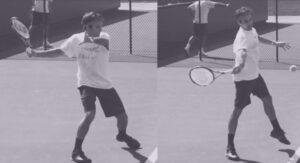
BELOW – Murray’s double bend
Whatever you’re working on, never forget the basics – watching the ball, keeping the feet moving, supportive breathing, a focused mind free of distractions and a full awareness of the hand and racket face.
What you do with your hand around and through the point of contact remains the ultimate point of awareness in tennis. Everything else you do is in support of this. Without spin and feeling on the ball, any power you have will be a liability.
If you’re wanting to access the effortless power of the professional game, then you’ll need to develop a smooth, controlled transfer of kinetic energy up through the body. A relaxed arm with a loose but stable grip will be essential for this.
Try holding the racket with just your index finger and thumb; Find a grip with these two fingers that allows you to effortlessly swing the racket head through, without using the arm muscles, while also keeping the ball roughly on target, drop feed yourself until you have control of the motion and the direction – this will probably be the beginnings of a western or semi-western grip. Note how much faster the racket head comes through and how little effort is needed. Then try using the rotation of the body to bring the arm and racket through.
All too often people have pain in their arms, shoulders and the rest of the body from holding the racket too tight, using the wrong grip or just trying way too hard. Too much tension in the mind and body usually leads to problems.
the forehand
The following videos perfectly show the relaxed modern footwork and game from a slow warm-up to some faster hitting as they get going.
The commentary is also a very informative and insightful addition. Thanks to the youtube channel – My Tennis HQ
Note the relaxed footwork and the amount of open and semi-open stance from the first ball, on forehands, backhands, slices whatever. The freedom of the footwork and the relaxed hitting arm are key factors of the modern game.
The following sequence highlights the main teaching points of the pro forehand.
Remember it’s a flow though! not a multi-tasking checklist. To help with this try to only focus on one point at a time until it is fully automated, and bare in mind that when a professional player tweaks their technique or game it may take months of training, many hours a day, to fully assimilate and realise the benefits of that change… so be patient.
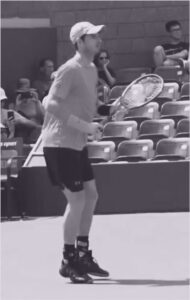
- It all starts with a fully alert and focused ready position, somewhere near the centre of the range of shots you might receive.
- The feet should be constantly dancing and moving. It’s far easier to move if you’re already moving. Staying light on the balls of your feet is the precursor to a an explosive first step.
- A wide base will aid lateral movement and a quick first step, it will also lower the centre of gravity.
- Knees will be bent slightly to engage the quads and glutes, creating the tension needed to push off in the direction of the ball.
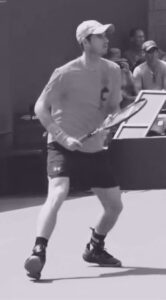
- The ‘split-step’ or ‘skip-check’ is a physical skip and a mental check where both feet leave the ground simultaneously and the mind focuses on the moment of reaction – the opponents strike. You should try to perform this just before the opponent’s strike, so that you’re landing as they strike.
- The quickest way to move is to let your head and upper body lead the way. Push off with the opposite leg as you lean in the direction you’re heading. This foot may pivot as you push off.
- The racket is moving from resting ready position to out in front of the body to find the ball. The structure of the hitting arm is established immediately with a single bend at the wrist, or a double bend at the elbow and wrist.
- A stable wrist and a strong, as in clear, not tight grip is vital to unlock the full power of the racket and increase racket head speed. In this case it’s a semi-western grip.
- The left hand will be positioned to initiate the unit-turn rotation up of the upper body.
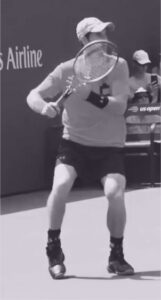
- This is the ‘Find the Ball’ moment. If the ball is moving slowly this is where your racket will loiter, as you stalk the ball.
- The hitting structure of the racket arm is now being set in place by the non-dominant arm.
- A stable laid back wrist is being reinforced by the left arm maintaining the shape of the racket arm.
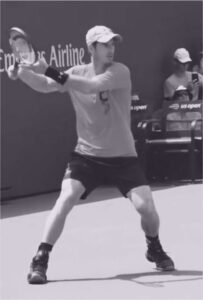
- The stance is opening and widening, as the final step onto the racket leg is made.
- The left hand lets go to allow the unit turn to complete, as the chin nears the opposite shoulder.
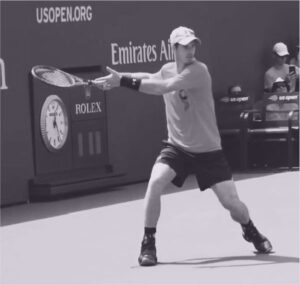
- This is around the moment of the SMOOTH transition from part one to part two, from load to explode. From the setting up of, to the actual most important movement in tennis. Everything else is the preparation for and completion of this movement.
- The unit turn is complete. The chest has moved from facing the target area to facing the side-fence.
- The racket has reached the ‘Pat the Dog’ moment.
- With more compact preparations evolving to deal with the advancing technology speeding up the game, you should really try to keep the racket head and preparation contained to the same side of the body as the strike. The bigger the swing the more time you need to hit that ball out in front of you.
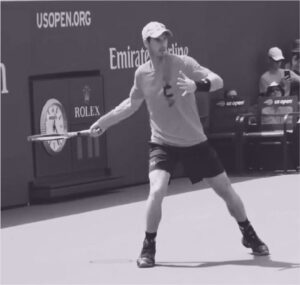
- The hips have opened as the unit turn now unwinds, and the left arm starts to get out of the way.
- The racket has dropped ‘into the slot’ and the bodyweight has been fully loaded onto the racket leg.
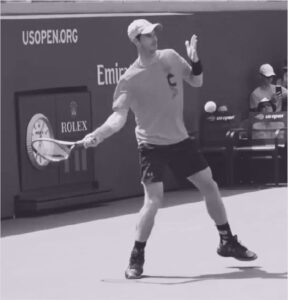
- The racket-face is naturally opening up to the ball, from the previously closed angle of this semi-western grip.
- The chest is back facing the target area.
- The weight is leaving the ground below the racket leg.
- This is really the heart of the matter right here, this is where the magic of timing really happens and racket head speed can really increase on the turn of the body, hand and forearm.
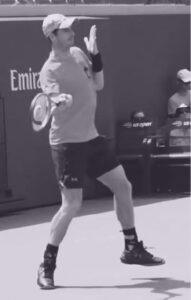
- The racket face has naturally opened to be facing the target area just at the right moment.
- The knee bend has helped with a dynamic launch into the air for contact.
- The contact point is out in front of the body. The double bend shape is still holding everything together, while the wrist is left firm but lose enough to keep turning the door handle.
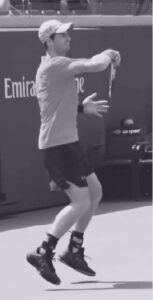
- You won’t need to be fully airborne unless you plan on being the club champion, but this is where the full force has been released onto the ball.
- The steeper the racket path the more height and spin. The lower the finish the lower the ball will go. The looser the grip the more power.
- The elbow is now higher than the racket face again as the brush completes.
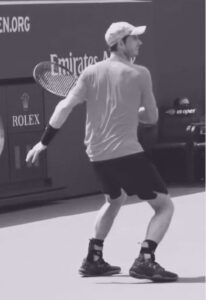
- The natural force of the kinetic chain unwinding brings the chest around to face the opposite side-fence. Chin now close to the other shoulder.
- The bodyweight has landed on the opposite leg, ready for an immediate recovery.
This is just one forehand example of the many that are out there; all of the best will have a similar process but with unique personal styles and slight variations. The pro forehand continues to evolve with a wider range of finishes from over the head to below the hips becoming necessary to deal with the speed and spin of the pro game.
Though if you come back to the warm up, the shoulder finish is the blueprint from which all that variety comes. The footwork is natural. If the ball is right in front of a player, and they have the time and space they may step into the ball very often continuing to move forwards after the shot. If the ball is deep, wide, fast or high, which covers most shots in professional tennis, then an open stance is more efficient, and that’s pretty much how it’s always been at the very highest levels.